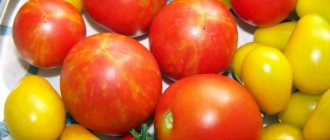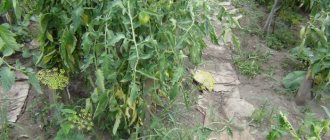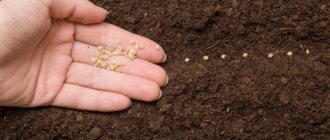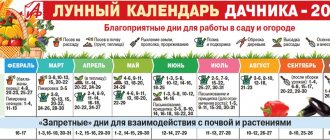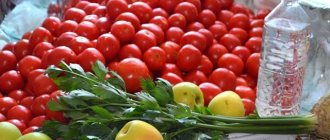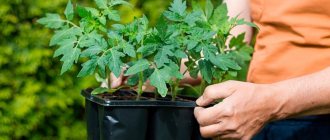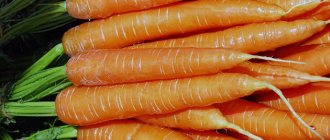It often happens that we sow plants completely involuntarily - we drop seeds on the garden bed, and they grow healthy and strong. And the soil, it would seem, is not suitable for growing this or that variety, but a tomato thrown on the ground suddenly germinates and begins to develop. This suggests that many seed crops can be planted even in winter.
The main thing is to take care of the shelter. Then in early spring you can wait for the first shoots. Tomatoes planted in this way grow hardened and have strong immunity. The seedlings are in no way inferior to February or March sowings. Plants tolerate temperature changes well and are resistant to many diseases.
How to plant tomatoes before winter
It would seem that planting tomatoes in cool soil is not the best way, but it gives good results and saves the grower’s time in the spring. When sowing in autumn, no cutting of shoots is required. The seedlings grow until they need to be transplanted to a permanent location. In this case, not only seedlings, but also seeds are not required. Tomatoes are planted whole, and they sprout on their own in harsh winter conditions.
Tomato seeds have a high survival rate. As frost approaches, dig holes no more than 15 cm deep. Place whole tomatoes in the hole at a distance of 20 cm, sprinkle them with soil and compact it a little. Fill the hole with dry leaves, hay or other mulch. This is where all manipulations end until spring. You just have to wait until they sprout and grow a little so that they can be transplanted to a permanent place.
In what month should you sow tomatoes for seedlings in the Moscow region?
In the capital region, tomato seeds begin to be sown in mid-February and end in April. Such extended deadlines should not be surprising. Greenhouse varieties are always planted early. And the month of sowing tomatoes for growing in unprotected soil is calculated according to several parameters. Take into account:
- weather;
- ripening time;
- seedling age.
The territory of the Moscow region is vast, so there are differences in the duration of the frost-free period. For example, in the Naro-Fominsk region it is 102 days, and in others – from 120 to 125 days. At some dachas there are no frosts after May 10-20, but at others they do occur. It depends on the terrain. In abnormal years, the temperature drops to 0 ℃ and lower even in the first ten days of June.
IMPORTANT! Seedlings are planted in the garden when stable heat is established (at night not lower than +10 ℃).
Experienced gardeners keep their statistics and know when to expect frost. Beginners can look on the Internet at archives of weather forecasters about the weather in the Moscow region by year. Knowing the approximate date of the beginning of the frost-free period, sowing dates can be calculated using the formula (date of transplanting to the garden - (age of seedlings)), where the optimal age of seedlings is:
- for early ripening varieties - 40-50 days;
- mid-season - 60 days;
- late ripening – 60−70 days.
How to determine the timing of sowing tomato seeds for seedlings is shown in the table.
| Varieties by ripening time | Approximate dates for planting seedlings | Approximate dates for sowing seeds |
| early ripening | May 20−25 | April 1−10 |
| mid-season | March 20−31 | |
| late ripening | March 1−15 |
Seedlings are planted in greenhouses earlier (mostly in early May), so the timing of seed sowing is delayed by almost a month. Late-ripening varieties - the last ten days of February, early-ripening and mid-ripening - the first ten days of March.
How to sow tomato seeds before winter
They are laid out in the garden bed, sprinkled with soil, and then the crops are insulated for the winter. They can be covered with hay or other mulch. Spruce branches are also suitable for this purpose. It will protect winter plantings from frost. In this way, it is better to sow tomatoes in a narrow bed. In the spring you can easily cover it with agrofibre, placing arcs on it that will support the fibre. Even heat-loving varieties can be planted before winter.
Women's jeans: before you buy them, you need to pay attention to one detail
Smooth and fresh skin: dermaplaning, or why a woman needs to shave her face
A Brazilian travels 36 km by bike every day to take his loved one home.
Step-by-step soil preparation in a greenhouse
When planning winter sowing of tomatoes, it is important to create suitable conditions. Work begins a month before planting the seedlings. In the summer, insects and bacteria accumulate in the greenhouse, so it is necessary to treat the frame, shelving and all accessories, as well as equipment and soil. Using a shovel, you can remove a 30 cm layer of soil and replace it with turf soil. Hay and leaves, ash or lowland peat, as well as green manure are laid under it. In such soil, the plants will take root well over the winter, and thanks to fertilizing, they will prepare for abundant fruiting.
Next, the soil is fertilized with granulated superphosphate, chicken or rabbit droppings. The turf soil is sifted to get rid of pest larvae. You can use the drugs Nematophagin and Batolin-T.
Sowing under straw
This is a fairly common method that guarantees plant protection from brown spot and root rot. For 1 sq.m. you will need about 10 kg of straw. The soil had to be disinfected with a weak solution of potassium permanganate. Place rotted straw at the bottom of the holes, 15 cm deep. Place ripe and large fruits on it.
Naturally rotten tomatoes can be used, but diseased fruits should not be used. The fruits are covered with straw, a layer of 12-15 cm. With the arrival of spring, make a mini-greenhouse over the garden bed. Winter seedlings are planted in a permanent place at the end of April. Initially, the seedlings are slightly behind in growth compared to home seedlings, but the discrepancy decreases during the first month.
Exotic way
Throw soured pickled tomatoes (not canned) onto a compost heap or into humus. In early spring, compost is scattered around the site as organic fertilizer. It is likely that the tomatoes will sprout even with such careless planting.
Rare shot: Viktoria Isakova showed her grown-up daughter from Yuri Moroz (new photo)
If there is little snow, there will be no harvest: December 16 is Ivan the Silent Day
Lost weight: what Sofia Tarasova sacrificed for the sake of “VIA Gra” (new photos)
Sowing on compost
Place whole ripe fruits in a hole with prepared compost from organic household waste and sprinkle them with soil or cover them with branches. In winter, the tomatoes will rot, leaving high-quality seed material. After the snow has melted, the seedlings should be protected with horticultural fiber or film from morning frosts.
When the first leaves appear, the plants are temporarily transplanted into a greenhouse or covered with a greenhouse. The seedlings are planted in open ground after they have grown stronger. This method of cultivation gives the seedlings an advantage: a well-developed root system, perception of negative climate factors without loss.
It is advisable to use pure varieties as planting material, since hybrids may disappoint with not the best results.
Suitable varieties
The market offers a huge number of varieties of this crop, which can be adapted to a wide variety of growing conditions. But for pre-winter planting, it is better not to use random varieties, but to prefer those already proven by experience:
- Rocket is a low-growing, compact bush. And although under traditional conditions this variety is demanding of watering, when planted in autumn it can go without water for quite a long time. The fruits are elongated and are intended for both fresh consumption and canning.
- Labrador is a high-yielding, early-fruiting variety. Good for open and protected ground. The fruits are large, with excellent taste, but cannot be stored for long.
- Ox heart is grown both in central Russia and in the southern regions. Powerful spreading bushes, fleshy tasty fruits. It is interesting that during traditional cultivation, Ox's Heart is often affected by late blight, but when planted before winter, the variety is not susceptible to this disease.
- Alaska is an early, disease-resistant variety. It is possible to grow it at home. The fruits are regular in shape, large in size, and are used fresh or canned.
Please note: for winter planting it is better to use “pure” varieties rather than hybrids. The fact is that it is unknown how the seeds of hybrids will behave in new conditions and what the result will be in the next generation.
Disadvantages of autumn sowings
Along with the many advantages of this method, which we discussed above, autumn planting of tomatoes also has some disadvantages:
- there is no guarantee that all seeds will germinate;
- some seedlings may become barren flowers;
- albeit in a small volume, this method requires compliance with agrotechnical rules for caring for crops.
As you can see, sowing tomatoes before winter has significantly more advantages than disadvantages, so it makes sense to use it.
Why is it more convenient to plant tomatoes in the fall?
There are several main advantages of this technique that every amateur agronomist will remember. Firstly, you do not have to prepare the seedlings for the upcoming planting. The preparatory stage is often called the most difficult, since you need to maintain the distance between the seeds, maintain temperature conditions and spend a lot of time growing seedlings. If you are planting tomatoes for the winter, you can skip all these steps and start gardening in the spring.
Here are the main advantages of this approach:
- you don’t waste your time preparing seeds and growing seedlings;
- wintering in the ground triggers the process of natural selection, so only the strongest seeds will grow;
- you don’t have to prepare a place in winter to store seedlings;
- the plants will be much stronger, since the growth process occurs naturally;
- Due to wintering in natural conditions, tomatoes acquire immunity to almost all diseases.
Despite many advantages, this method also has disadvantages. The main disadvantage is the fact that the seeds sprout only after the onset of heat. If there is a sudden frost, the seedlings may die. It is very important to choose the right time for planting seeds so that the tomatoes do not sprout in the fall and die from the cold.
An additional disadvantage is that the seedlings sprout in bunches - several seedlings can sprout from one hole at once, since you will not be able to control the number of seeds at each point. As a result, you will have to spend time dividing the seedlings and planting the plants in other holes or getting rid of the weakest plants.
Let's sum it up
Some people perceive this innovation with distrust. Not everyone can risk using the method of autumn planting tomatoes. These methods of growing tomatoes, which we described in our article, were tested relatively recently, but today they are successfully used by many gardeners and farmers.
The effectiveness of autumn sowing lies in the unpretentiousness of this process and the receipt of a stable early harvest. Unlike seedlings grown on a windowsill, winter sowing produces seedlings that are completely acclimatized to your region of residence.
You should think about using this method after analyzing all its advantages and disadvantages. Compliance with all sowing rules will help you get an early and abundant harvest.
Found a violation? Report content
Seedling care
The future harvest of tomatoes will depend on regular care. The following activities are required:
- loosening the soil around the bushes;
- watering every two weeks;
- weeding;
- shading bushes on hot days;
- fertilizing with a solution of chicken manure twice during the summer.
Important! Tomatoes develop well at a daytime temperature of no more than 25 degrees, and at night - 7-8 degrees lower.
With such care and compliance with the temperature regime, the harvest will be rich, the fruits will be of the correct shape, beautiful, juicy, and environmentally friendly.


